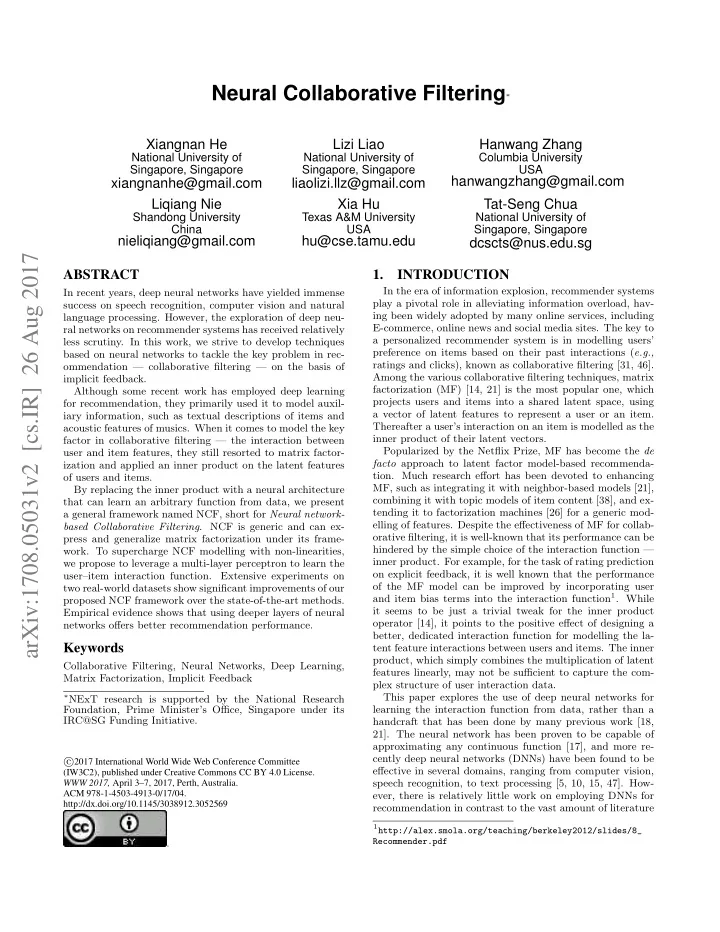

Neural Collaborative Filtering ∗ Xiangnan He Lizi Liao Hanwang Zhang National University of National University of Columbia University Singapore, Singapore Singapore, Singapore USA hanwangzhang@gmail.com xiangnanhe@gmail.com liaolizi.llz@gmail.com Liqiang Nie Xia Hu Tat-Seng Chua Shandong University Texas A&M University National University of China USA Singapore, Singapore nieliqiang@gmail.com hu@cse.tamu.edu dcscts@nus.edu.sg arXiv:1708.05031v2 [cs.IR] 26 Aug 2017 ABSTRACT 1. INTRODUCTION In the era of information explosion, recommender systems In recent years, deep neural networks have yielded immense play a pivotal role in alleviating information overload, hav- success on speech recognition, computer vision and natural ing been widely adopted by many online services, including language processing. However, the exploration of deep neu- E-commerce, online news and social media sites. The key to ral networks on recommender systems has received relatively a personalized recommender system is in modelling users’ less scrutiny. In this work, we strive to develop techniques preference on items based on their past interactions ( e.g., based on neural networks to tackle the key problem in rec- ratings and clicks), known as collaborative filtering [31, 46]. ommendation — collaborative filtering — on the basis of Among the various collaborative filtering techniques, matrix implicit feedback. factorization (MF) [14, 21] is the most popular one, which Although some recent work has employed deep learning projects users and items into a shared latent space, using for recommendation, they primarily used it to model auxil- a vector of latent features to represent a user or an item. iary information, such as textual descriptions of items and Thereafter a user’s interaction on an item is modelled as the acoustic features of musics. When it comes to model the key inner product of their latent vectors. factor in collaborative filtering — the interaction between Popularized by the Netflix Prize, MF has become the de user and item features, they still resorted to matrix factor- facto approach to latent factor model-based recommenda- ization and applied an inner product on the latent features tion. Much research effort has been devoted to enhancing of users and items. MF, such as integrating it with neighbor-based models [21], By replacing the inner product with a neural architecture combining it with topic models of item content [38], and ex- that can learn an arbitrary function from data, we present tending it to factorization machines [26] for a generic mod- a general framework named NCF, short for Neural network- elling of features. Despite the effectiveness of MF for collab- based Collaborative Filtering . NCF is generic and can ex- orative filtering, it is well-known that its performance can be press and generalize matrix factorization under its frame- hindered by the simple choice of the interaction function — work. To supercharge NCF modelling with non-linearities, inner product. For example, for the task of rating prediction we propose to leverage a multi-layer perceptron to learn the on explicit feedback, it is well known that the performance user–item interaction function. Extensive experiments on of the MF model can be improved by incorporating user two real-world datasets show significant improvements of our and item bias terms into the interaction function 1 . While proposed NCF framework over the state-of-the-art methods. it seems to be just a trivial tweak for the inner product Empirical evidence shows that using deeper layers of neural operator [14], it points to the positive effect of designing a networks offers better recommendation performance. better, dedicated interaction function for modelling the la- Keywords tent feature interactions between users and items. The inner product, which simply combines the multiplication of latent Collaborative Filtering, Neural Networks, Deep Learning, features linearly, may not be sufficient to capture the com- Matrix Factorization, Implicit Feedback plex structure of user interaction data. ∗ NExT research is supported by the National Research This paper explores the use of deep neural networks for Foundation, Prime Minister’s Office, Singapore under its learning the interaction function from data, rather than a IRC@SG Funding Initiative. handcraft that has been done by many previous work [18, 21]. The neural network has been proven to be capable of approximating any continuous function [17], and more re- cently deep neural networks (DNNs) have been found to be c � 2017 International World Wide Web Conference Committee effective in several domains, ranging from computer vision, (IW3C2), published under Creative Commons CC BY 4.0 License. speech recognition, to text processing [5, 10, 15, 47]. How- WWW 2017, April 3–7, 2017, Perth, Australia. ACM 978-1-4503-4913-0/17/04. ever, there is relatively little work on employing DNNs for http://dx.doi.org/10.1145/3038912.3052569 recommendation in contrast to the vast amount of literature 1 http://alex.smola.org/teaching/berkeley2012/slides/8_ Recommender.pdf .
Recommend
More recommend